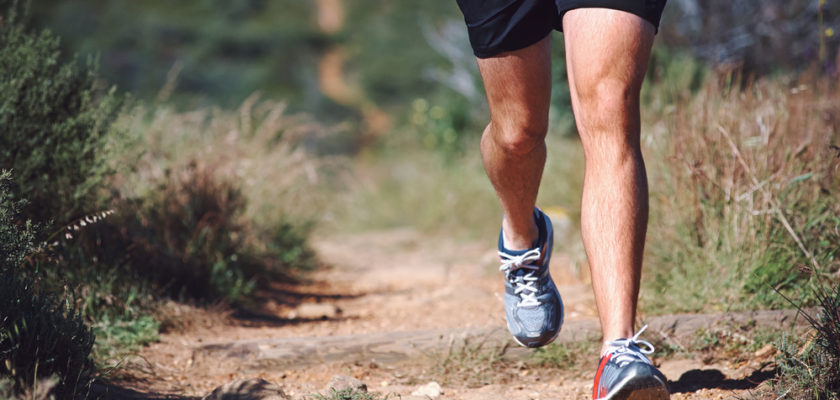If you’re a long-distance runner, each of your feet impacts the ground on average between 80 and 100 times per minute. This results in thousands of foot-strikes per hour. This can have an enormous impact on your chances of injury over the course of your running career.
So if you’re looking to avoid injury, it’s extremely important to pay attention to how your running stride impacts your feet. It’s even more important if you’ve never looked at the consequences before.
What types of factors affect our stride?
Is there a right vs wrong stride?
Does our stride change over the course of a run?
We’re going to focus on the connection between foot-strike patterns and running stride. We’ll also think about how both might affect the way our bones and muscles react to longer, more exhausting runs.
Environment Affects Stride
It can be important to take note of where you run. This is because environment can change the way even trained runners hit the ground with each footfall.
As your feet hit the ground with momentum, every time you take a step, the impact is greater than your body weight. The amount of impact absorbed by the ground depends on your stride and how hard the surface is. It’s for this reason that you should determine what kind of environment you’ll use for your runs, and stick to it.
You may run differently on concrete than on dirt. You’ll run differently in a challenging obstacle race. You’ll also experience a completely different sensation when running on a treadmill. In the same way, hot / cold weather can alter the way your feet connect with the ground or the speed at which you’re running.
These different factors affect stride, and can change the way your feet strike the ground.
Where you run depends on what you want out of it. Running on concrete or pavement can cause muscle fatigue or stress fractures in your feet, ankles and shins. That being said, it can be beneficial if you’re training for a marathon or road race.

If you’re not used to the kind of punishment your feet will take on pavement during a race, then you’ll wear down a lot faster and you could be in lots of trouble!
If you’re curious as to what “in trouble” looks like – take a look at how mymarathon performance went!
Those who choose to train or run on pavement should take extra care when choosing what foods to consume for nutritional value.
If your body will endure that extra bit of punishment, then look for foods that contribute to stronger bones, ligaments and tendons. Fruits, vegetables, dairy, and fish are good examples. A pescatarian diet would be really effective in combination with plenty ofgreen vegetables.
If you’re a casual runner just in it for health reasons, then a treadmill might not be a bad idea if you keep a couple of things in mind.
Treadmills take a period of adjustment before you get used to them. Because the treadmill is a much softer surface than soil or concrete, it’s easier on your muscles, bones, joints, tendons and ligaments. Even considering this, there is still a separate set of risks involved.
When the treadmill belt runs underneath you, it can pull you with it as you push away with your feet. This motion can reduce your stride and irritate other parts of your body such as knees, back, and hips.
To counter this phenomenon, you need to lift your feet faster than you would while running on other surfaces. If you can’t compensate for this motion, then you should stay away from treadmills and stick to the great outdoors!
Why not try and run shirtless if you can next time you go outdoors too? Here’s 9 reasons to try it.
If you’re a more aggressive, competitive runner and the weather outside isn’t ideal for a good run, there are approaches you can take to change your stride and foot-strike as little as possible.
Hitting the Right Stride
The right stride isn’t the same for everyone. Different strides affect different muscles in the feet. Different sets of muscles also support different types of footfalls. What’s right for you depends on the types of muscles you’ve developed more.
Researchers increasingly conclude that foot-strike patterns change depending on factors such as environment or distance. Because of this, many runners question whether it matters at all!

The simple answer is this: It’s up to you! You know your body better than anyone else, and you know what kind of foot-strike patterns stress the bones and muscles in your feet the most. Find the right balance.
The most important thing is that you stick with the same pattern throughout your run. Not doing so can lead to joint stiffness in the knees. It can also lead to short-term or long-term injury of the bones and muscles in your feet.
Various studies have conducted research looking at the relationship between injury and foot-strike patterns [1].
They found runners had recurring injuries more often when transitioning from one running pattern to another. This was in comparison to runners who stick with the same stride and foot-strikes throughout.
One study focused on different types of injuries that occurred during different types of footfalls. This might prove interesting if you’re still deciding which type is best for you.
During this study, researchers found that knee stiffness is greater than ankle stiffness for runners who land on the forefoot. In comparison, those who land on the heel are subject to greater ankle stiffness. These conclusions can help runners determine the type of muscular endurance that would be best to train for.
Running When You’re Tired
Even if you think you’re consistently hitting the right balance between stride and foot-strike, you might be wrong! The length of your stride changes throughout your run. During a longer, more arduous run or marathon, you tend to start with longer, stronger strides.
As you begin to tire and your body shows signs of fatigue, you put a lot less “oomph” into your stride, and they become a lot shorter. In turn, your foot-strike patterns are negatively affected and the chance of injury increases.
If you’re looking to stop yourself getting tired as quickly, you’ll want to add some HIIT training into your routine.
Scientists have published new research on the subject in the Journal of Sports Sciences. To do this, they started by putting 14 forefoot runners through a long run [2]. They then measured and documented some potentially changing conditions such as landing mechanics and torque affecting different areas of the foot both before and after the activity.

Forefoot runners, in particular, are those who land on the front of the foot rather than the heel. If this is you, then take note of the outcome of the study. The research found that running stride changed pattern when more endurance was required. It concluded that runners should train for a consistent footfall to reduce the chance of injury during a marathon or competitive running.
Specifically, the runners who were trained to land only on the forefoot quickly transitioned to a running style in which the heel was impacted most.
The research also found something surprising. These changes became significant even before the fifteen-minute mark had passed. This suggests casual runners should pay even more attention.
It would be easy to think that this isn’t a big deal. But if the shoes you wear are adapted for a specific running pattern (forefoot, midfoot, or heel), then your footwear might quickly become ineffective at cushioning the impact of each footfall.
Also, if the training you do is for a specific type of muscular endurance, then your training might quickly be irrelevant when fatigue sets in.
In other words, be careful during long runs, and take note of how your body and your feet react!
The general rule of thumb for most runners is well-known: don’t swing your arms too loosely, tilt your body forward only slightly, and take short, quick strides.
As you can see, though, many other factors contribute to how you run, and all these can change your stride and foot-strike. How you run is in large part up to you, but definitely keep in mind that there are pros and cons to each individual style.
So, what’s your preferred running stride? And do you prefer running, walking, or hiking?
Have you or anyone you know experienced any feet or leg issues or injuries in the past?
Then why not share this article with them and help them out? 🙂
References:
[1] Research Gate: Joint Stiffness During Running With Different Footfall Patterns –https://www.researchgate.net/publication/295485018_Joint_stiffness_during_running_with_different_footfall_patterns
[2] US National Library of Medicine – Do footfall patterns in forefoot runners change over an exhaustive run? – https://www.ncbi.nlm.nih.gov/pubmed/27003185

